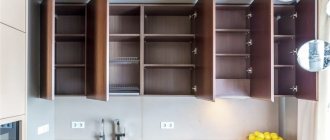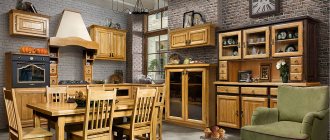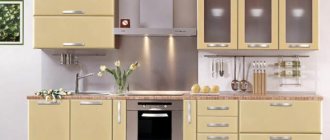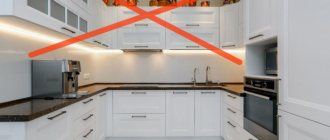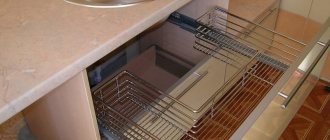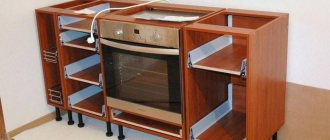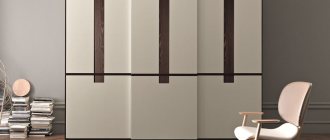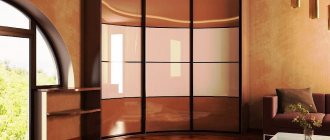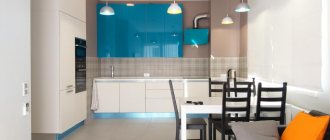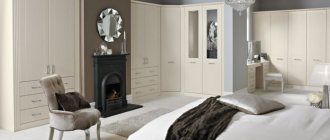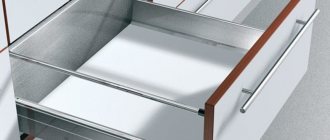Standard sizes of kitchen cabinets: analysis of the main parameters
The kitchen is a special room in the house, requiring a careful and thoughtful approach to organizing the workspace - choosing the size and method of placing furniture, its quantity and internal contents. The room must be functional, safe and comfortable, that is, meet basic ergonomic requirements.
The selection of furniture sizes and options for its location occurs at the project development stage, taking into account the area, configuration and planning features of the room. You can purchase a ready-made set for a typical kitchen by selecting the required number of modules.
For rooms with a non-standard layout, it is better to order furniture according to individual sizes. The same applies to small-sized kitchens, where it is not possible to install standard-sized modules. Today’s material will tell you what the standard sizes of kitchen cabinets are and the nuances of properly organizing your workspace in the kitchen.
Standard sizes of kitchen cabinets
Types of kitchen furniture
When making standard kitchen furniture presented in stores, the average height of a person is taken into account - this makes it universal and easy to use. If a person is taller than average, then you can adjust the height of the hanging drawers and choose floor cabinets of the required height.
Furniture parameters depending on height
In the kitchen you can find 4 types of furniture.
Table 1. Types of furniture
| Name | Description |
| An essential element of a kitchen set, the countertop of which is used as a work surface, installation location for a hob or sink, or other household equipment. The interior space is equipped with shelves, drawers, and other built-in modules for storing kitchen utensils and products, as well as installing built-in equipment - an oven, dishwasher and washing machine. | |
| Attached to the wall above the work surface. Used for storing dishes, food, small kitchen utensils, and household equipment. Some kitchen sets do not require wall cabinets, or partially replace them with open shelves. Wall cabinets are also used to install exhaust equipment and local lighting sources for the working surface. They are equipped with solid or transparent facades. | |
| It combines the lower and upper panels and is used to accommodate built-in equipment – refrigerator, oven, washing machine, dishwasher, microwave. Can also be used as a spacious storage area. | |
| It is used for L- and U-shaped arrangement of kitchen units. Allows you to save free space. |
Video - Types of kitchen furniture
Dishwasher connection
Next, you should consider connecting such an important attribute as a dishwasher; its connection principle is similar to laying communications to a washing machine.
There are also three main installation points: the installation of electricity, the removal of cold water and sewerage.
The analogy with a washing machine is almost complete, but the important thing here is that all communications to this type of equipment should be installed directly in the place where the washing cabinet is located - in no case behind the device itself!
Therefore, in the process of purchasing, planning and arranging in the kitchen, all this must be taken into account, as well as the fact that all other communications (gas risers, for example) must pass on one side of the appliances.
Features of choosing furniture size: what to consider
When choosing furniture for the kitchen, take into account the area of the room - the set should not take up most of the free space, but at the same time it must be functional and meet safety requirements. This can be achieved through the correct selection of the main furniture parameters - height, depth and width.
There are several criteria that must be taken into account when choosing the size of kitchen furniture.
Table 2. Criteria for choosing the size of kitchen furniture
Anthropometric data of the kitchen owner
| Illustration | Description |
| If a person is taller than average or has other physiological characteristics (disabilities), the parameters of kitchen furniture differ significantly from the standard ones - the height of the countertop, hanging modules, the method of opening them and the internal equipment change. | |
Design and dimensions of typical kitchen sinks | Equipment of this type is produced using standard sizes. So, a single-chamber sink has a width of 50 cm, a half-chamber sink has a width of 60 cm, and a two-chamber sink has a width of 80 cm. |
Built-in household appliances: dimensions | Kitchen appliances also have certain dimensions that need to be taken into account. Oven, hob, washing machine, dishwasher, stove, refrigerator have a limited selection of sizes. |
The power of the hob and the principle of its operation | The height and type of hood depends on the power of the hob. It is also worth considering that the panel can be electric or gas. |
Design features of exhaust equipment | The method of location of the hood is taken into account: mounted or built-in, as well as the principle of its operation (flow-through, circular). When installing a flow-through hood, it is necessary to provide space for placing the air duct. |
| It is important to take into account not only the height of the room, but also the presence of suspended tension or plasterboard structures on the ceiling, so that there is free space between the top cover of the wall cabinet and the ceiling. |
Conventionally, the kitchen set can be divided into several main zones:
- The lowest one, which contains a storage area for rarely used and heavy items, equipped with drawers.
- The lower one, which is used to store cutlery and frequently used kitchen utensils.
- The middle one, in the form of a working surface, which it is advisable to leave as free as possible.
- High, which is located at eye level and is used for storing dishes, frequently used kitchen utensils and products.
- The highest, located under the ceiling and used for light, rarely used items.
Taking into account the above, first you should decide on the need to equip those storage areas that are located in difficult reach - the dimensions of the kitchen unit will depend on this.
For greater clarity, you can draw an outline of the walls and the perspective of the chosen solution
You should also measure the room and draw it to scale on a sheet of paper so that you can choose the most optimal option for arranging furniture. The main modules are cut out of paper and moved on the plan, choosing their best location.
Bottom row cabinets
As noted earlier, the bottom row of cabinets is a mandatory element of the kitchen set.
Schemes of kitchen modules
The standard sizes of cabinets included in this group of furniture are as follows:
- The total height of the lower cabinet from the floor to the top of the worktop is 850 mm.
- The height of the base or bottom point of the cabinet is 100 mm from the floor.
- The optimal depth of a base cabinet is 560 – 580 mm , the minimum value is 460 mm . When equipping a drawer, take into account that 450 mm is the length of the drawer itself and 10 mm provides free space to the rear wall of the structure.
- The depth of the tabletop depends on the depth of the cabinet and protrudes from the front by 30-50 mm , and from the back by 50-100 mm. The most popular depth is 600 mm, as it corresponds to the parameters of typical household appliances.
- The width of the facades varies from 300 to 400 mm.
- The shelves inside the cabinet should be located at a distance of 200 - 400 mm - this is the optimal value, which can be changed at the request of the furniture owner.
Ergonomics in the kitchen
Top row cabinets
Properly organizing the storage of dishes, small kitchen utensils and products will allow a thoughtful approach to choosing the size and height of the hanging modules.
Upper cabinet options
Of the main parameters of mounted modules, the following are noted:
- The height of the upper cabinet is 790 – 900 mm.
- The depth of the cabinet varies from 300 to 350 mm , in other words, it is ½ of the depth of the working surface (countertop).
- The distance from the table top to the bottom edge of the pendant module is at least 450 mm. Taking into account the height of the kitchen owner, the indicated value can be increased to 550 - 600 mm.
- The width of the fronts must correspond to the width of the fronts of the lower cabinets.
- Particular attention is paid to the distance between the hood and the equipment located underneath it. So, the distance from the gas stove should be at least 750-800 mm and 700-750 mm from the electric hob.
- The distance from the floor to the top point of the wall cabinet can be 2100 - 2500 mm.
Standard size of wall cabinets installed in the kitchen as furniture elements
Corner cabinets
Often the kitchen set has an L-shaped arrangement. This is convenient and justified in a small room area. Corner modules are also used for peninsular and U-shaped furniture arrangements. The purpose of these storage areas is no different from conventional cabinets, but the dimensions and configuration of the module are an important factor.
Corner floor module
The main parameters of corner modules are as follows:
- The height of the modules from floor to ceiling is 1800 – 2500 mm (for a column cabinet).
- The depth of the top drawer is 300 – 400 mm.
- The depth of the bottom drawer is 460 – 500 mm.
- The width of the façade is 300 – 400 mm.
Corner element for L-shaped kitchen
The remaining parameters: the thickness of the tabletop and the height of the hanging modules are identical to conventional modules.
Video - Features of the arrangement of furniture in the kitchen
What is included in the set of built-in household appliances for the kitchen
You can integrate many large and small appliances into your kitchen set. Of course, there are appliances that are necessary for any kitchen space. This includes the following positions:
Fridge. This freezer is a necessary element of any kitchen. The most popular built-in refrigerators today are two-chamber ones. However, installing a device with such characteristics is not always justified. For example, single-chamber refrigerators equipped with a freezer may be suitable for small families. If necessary, the latter can be installed separately.
Cooking panel and oven. In the case of integrated technology, there are two options for installing these devices: dependent and free. The first of them takes into account the general design of the hob and oven, which are controlled using a common panel.
The integration of appliances will allow you to rationally organize the space, creating much more opportunities for interesting design solutions for the kitchen interior
In turn, the free arrangement of these cooking elements allows them to be positioned independently of each other. Thus, the hob and oven can be connected to different power sources. For example, a cooking surface can be connected to a gas pipe, and an oven to a regular outlet, since electronic options have more precise temperature control.
Hood. A set of built-in kitchen appliances usually includes this device. Today there are two types of integrated hoods, which differ in their operating principle: equipped with an outlet and filtering. In the first case, the device collects contaminated air and helps remove it through the ventilation pipe.
Filtering devices are also called recirculation devices. These hoods are equipped with special filters that purify polluted air. After this procedure, he returns back to the kitchen.
Built-in oven in the kitchen
Helpful information! It is important to remember that the effectiveness of any exhaust device depends on its area. Experts recommend selecting devices of the same size as the dimensions of the hob. This will allow you to achieve maximum efficiency in air purification.
Dishwasher. Such a device is not a necessary element of built-in household appliances for the kitchen. Buying a dishwashing machine is not difficult. The range of these devices is quite wide. First of all, they differ in their volume. This indicator determines how much dirty dishes can be loaded into the machine at one time.
Finding the best location for your dishwasher depends on several factors. First of all, this is the size of the hose that is needed to remove dirty water. The size of the device is also important. Do not forget about the personal wishes of the apartment owners.
Ancillary devices that can be integrated into kitchen furniture include washing machines. Their location in the kitchen is aimed at saving useful space in the bathroom. There are also many small-sized devices that perform different functions. These include: microwave ovens, coffee makers, blenders, etc.
Using built-in household appliances is very simple, and the operating instructions will help you understand all the nuances of the purchased model of built-in household appliances
The price of a kitchen with built-in appliances varies depending on the cost of the set and devices. The cheapest sets, which include both furniture and appliances, can be purchased for 180-200 thousand rubles. More expensive complexes cost from 200 to 500 thousand rubles.
Work triangle
Correctly selected sizes of kitchen modules are inextricably linked with their location in space - the layout of the kitchen. The sequence of arrangement of floor and wall cabinets, as well as equipment, is dictated by the technological process of food preparation, which consists of several stages: storage, washing, preparation for cooking and cooking of products. For the convenience of carrying out these stages in a short time and with minimal energy consumption, an optimal arrangement of furniture with a separate functional purpose is provided: cabinets with dishes are located near the sink, cabinets with spices, dishes and auxiliary kitchen utensils are located near the stove.
The work triangle includes three main zones:
- A work surface that includes a countertop, stove, and microwave.
- Storage area consisting of a refrigerator and freezer.
- A clean area for washing dishes and food, equipped with a sink and dishwasher.
Working triangle rule
The arrangement of zones has the following sequence: refrigerator, sink, stove. In this case, the distance between them should be comfortable, not exceeding two arm lengths.
Organization of the technological process
What does ergonomics say?
Taking into account ergonomic requirements, the main elements of furniture in the kitchen must meet the following parameters:
- With a height of 165 cm, the height of the tabletop should be 850 - 900 mm. If you are taller, then leaning towards such a surface will be uncomfortable. The height is chosen so that it is 15 cm lower than the bend of the elbow.
Ergonomics ensures the safety and comfort of using kitchen furniture
Important step: measuring the kitchen
To choose the optimal size of kitchen furniture and how to arrange it in the room, the kitchen must be measured correctly.
Table 3. How to take kitchen measurements
| Illustration | Description |
| Measuring the room begins with the main wall at the level of the lower modules, at the level of the apron and at the level of the top point of the wall cabinets. Of the three sizes, choose the smallest one. | |
| Measure the wall adjacent to the main one. | |
| Determine the location of the hood. To do this, measure the distance from the floor to the existing exhaust vent. And the distance from the corner to the beginning of the exhaust hole and from the corner to the end of the exhaust hole. | |
| The drawing must reflect the location of the meter, if any. To do this, measure the distance from the floor to the edge of the counter. From the wall to the edge of the counter on which it is located and from the corner to the counter. | |
| The drawing marks the location of electrical points on the main wall. | |
| Mark the locations of electrical points on the wall adjacent to the main one. | |
| The next step is to mark the distance to the protruding elements - the window sill, radiator and heating pipe. |
You can develop a kitchen drawing on a computer using one of the many design programs. A special article will tell you about the main nuances of making kitchen furniture drawings yourself.
Video - Dimensions of kitchen cabinets and methods of their arrangement
Source
Dimensions of kitchen cabinets: standards and rules of ergonomics in the kitchen
The harmony of the space allocated for cooking largely depends on what kind of kitchen set you choose. In particular, the influence will be exerted not only by its appearance, the quality of the material from which the body is made, or the strength of the fittings, but also simply by the dimensions of kitchen cabinets, the standard of which not only exists, but is recommended for use even in the most unusual from an architectural point of view kitchens Let's see what sizes we are talking about.
Kitchen cabinet sizes, standard
Standard sizes of corner kitchen floor cabinets
The dimensions of the lower corner cabinets correspond to the parameters of the overall kitchen set. This takes into account such parameters as the height and depth of the slab, the dimensions of the sink and other built-in appliances. If we are talking about a small kitchen, then the maximum cabinet depth should not exceed 50 cm.
The most common dimensions are a corner cabinet 60x60 cm
The height of the corner lower structure corresponds to the general standard and is equal to 85 cm. The legs of such cabinets can be adjusted, like regular ones. The width of the models can range from 15 to 80 cm. The most common dimensions are a 60x60 cm cabinet, which is quite spacious and easy to use. The lower part is installed after attaching the upper part, and they must correspond to each other.
The most common design option mounted in the lower corner is a corner kitchen cabinet under the sink. Its dimensions can be varied and depend on the dimensions of the sink itself. In addition, the type of sink itself is taken into account - whether it is mortise or overhead.
Most often, corner models are included in headsets made to order. In this case, the parameters are calculated independently, the width can exceed 60 cm, the depth of the product can reach 80 cm. Often, in the corner cabinet on which the sink is installed, two facades or one folding door are used.
But many professionals recommend choosing the size of a corner kitchen according to your wishes, the main thing is that it is comfortable
What you need to know to size kitchen cabinets
To calculate the appropriate dimensions for kitchen cabinets, it is necessary to take into account some features regarding this process. If you have not had to do this before, of course, you may encounter various difficulties.
For everything to work out, you need to do the work sequentially, namely:
- First, calculate the area of the room by taking general measurements;
- then study the size of the specific part of the kitchen where you will presumably install the set.
The size of the cabinets will be determined, first of all, by the requirements for them.
It is highly advisable during preparation to create a project for the future kitchen, while implementing it, for maximum accuracy, in some 3D editor. Since in this way it is possible to achieve an understanding of the spatial arrangement of cabinets as accurately as possible.
You can develop a drawing on a computer using one of the many design programs. A special article will tell you about the main nuances of making kitchen furniture drawings yourself.
Of course, in order to carry out this embodiment, you will have to hire professionals or ask people with specialized skills to help you. However, if you also have the skills you are looking for, then you will not need outside help.
It is important that in the end the kitchen looks as harmonious as possible
Preliminary work
By starting to make your own kitchen set, you can win a lot:
- ideal compliance of dimensions with the shape and dimensions of the room;
- rational distribution of every centimeter of area;
- individuality of the scheme;
- significant savings of own funds.
First, you should estimate the location of each element of the room: household appliances, stoves, windows, cabinets, tables, and determine the location of the work area. Based on the data obtained, a sketch should be drawn.
If desired, such a drawing can be sketched using a special computer program. A detailed 3D model in volume will give a more detailed picture of the design of the future design.
After the manipulations have been carried out, a drawing of the kitchen set is made manually or using Photoshop. After printing out the plan, it is used to assemble the kit.
Parameters of cabinets installed in the bottom row
When installing cabinets in the kitchen in the bottom row, it is necessary to clarify the parameters of the room. At the same time, the design style of the kitchen set can also play an important role, provided that the cabinets are equipped with non-standard decorative elements.
Dimensions to consider when developing a kitchen drawing
However, there are standard values that we have devoted this article to, and we now need to study them.
Table 1. Standard parameters of cabinets installed in the bottom row
Total cabinet height
Tabletop overhang level
Height of spaces between internal shelves of cabinets
| Parameter | Meaning |
| As a rule, the total height of downward-mounted cabinets is at least 85 centimeters. This height is enough to create enough space inside the furniture to store various dishes and other kitchen utensils. | |
| The height of the plinth, or in other words, the height of the cabinets installed in the bottom row of the kitchen, from the flooring should usually be 10 centimeters. | |
The depth of the cabinets in our kitchen set, or rather its bottom row, has a standard value equal to 46 centimeters. So, if, for example, drawers are installed inside this cabinet, then:
from 56 centimeters to 58 centimeters are considered much more popular | |
The width of the tabletop, which is installed on cabinets and serves as our working surface, has three standardized sizes:
| |
The thickness of the installed countertop can also be represented by several standard indicators, namely:
This parameter will directly affect the strength and cost of your kitchen furniture. Accordingly, the thicker, the stronger. | |
Indeed, you will have to evaluate such an indicator, even if you had not previously suspected it. So, the level of overhang of the tabletop can be:
If you take into account the availability of this reserve, you can safely place behind the cabinets such engineering and network elements as: Usually they run along the walls, so in order not to get fancy and hide them, use the desired overhang. | |
The width of the facades is another indicator that has several standard sizes. They will be as follows:
Since furniture is now quite often made to order, as a rule, the width of the cabinets, and with them the fronts, really varies. Please note: you should not install furniture with a facade width of more than 90 centimeters, since such a wide cabinet will cause serious inconvenience when using the piece of furniture. | |
This parameter is usually:
Everything will depend on what purpose this or that locker has. These parameters, although they are standard, are not at all mandatory, you should also take this into account. |
All parameters listed in the table above are closely related to each other. Moreover, on the basis of each of them others are built, therefore, it is important to strictly take into account the dimensions, since only this can help you maintain and increase the maximum functionality and convenience of the space allocated for cooking.
Even if you order furniture with dimensions that are unsuitable for your kitchen, you can “replay” this situation on your own. For example:
- replace too low twist-out legs with parts of greater height;
- basically remove the legs;
- replace a cabinet that is too wide with a narrower one, etc.
Some parameters of the furniture you purchase can be adjusted, for example, you can unscrew the legs and screw longer or shorter parts
Of course, in most cases, to make the above changes you will need to pay additional money on top of what you initially spent, so it is better to make the right calculations right away. Then the kitchen will still look as organic as possible.
The most suitable standard tabletop sizes
As for the most suitable standardized sizes, for example, countertops measuring at least 60 centimeters are considered the most popular. The fact is that making the work surface smaller is simply not profitable, since you will need space to cook. In addition, if you install a tabletop of the required size, you can easily subsequently select built-in appliances, for example:
The countertop is the element of the kitchen set that requires special attention.
In general, ideally the countertop should be 90 centimeters in size , but this value is, of course, only suitable for large kitchen spaces. Although, there are also kitchens with countertops whose size is neither more nor less than 120 centimeters, however, we are, of course, talking about professional kitchens, or for those made in the loft style. Using such a large surface, you can even create an island in the middle of the eating or cooking area.
Advantages and disadvantages of built-in kitchen appliances
Until recently, appliances integrated into kitchen furniture were considered a luxury item. However, today this option has become widespread. The main advantage of built-in appliances is that they are practical and occupy a minimum amount of space.
Repairing built-in appliances is much more difficult than free-standing household items
Installing a kitchen set with built-in appliances can also reduce electrical energy costs. Furniture for individual functional elements, as a rule, is selected individually. The location of the devices inside the cabinets provides sound insulation, which is an important advantage.
Installation of equipment is carried out not only taking into account the usable space of a particular kitchen. During installation, the personal wishes of the owners are also taken into account. In total, this provides the necessary functionality and comfort. Another advantage of this technique is ease of installation. It is also worth noting the presentable appearance of the built-in elements.
Built-in appliances provide the kitchen not only with all the required technical devices, but also create the integrity of the interior
Integrated electric and gas appliances also have some disadvantages. First of all, they have a higher cost compared to conventional devices.
Note! When choosing a set of equipment, it is recommended to order a headset for it in advance. Installing built-in devices in finished furniture is often impossible, since its dimensions may differ from the required ones.
Before installing built-in equipment, you will need to discuss various nuances of the process more than once with a specialist. Because of this, more time is spent than in the case of installing conventional devices.
Integrated devices are location dependent. Therefore, their rearrangement is impossible. Repairing built-in household appliances requires intervention from only qualified specialists. It is highly not recommended to repair failed elements on your own.
Built-in kitchen appliances are an excellent solution that will help create comfort and convenience even in the smallest kitchens
Parameters of top-mounted cabinets
Wall kitchen cabinets also have their own standardized parameters. Knowing them, you can easily decide at what height to install the upper segment of the headset. Of course, calculations, as in the case of cabinets for the lower part of the kitchen, must be carried out in advance so as not to decide in the process which cabinet will go in which part of the room. Let's take a look at what standard features of external cabinets we need to know about.
Like the cabinets in the lower segment of the kitchen, the upper elements of the set have their own standardized sizes
Table 2. What are the standard sizes of kitchen wall cabinets?
| Parameter | Characteristics |
| Upper cabinet height | So, this parameter in the average value will be:
|
| Depth of wall cabinets | The standard depth for overhead cabinets is approximately 30 centimeters. Please note: if the kitchen had a large working surface, the depth of the cabinets should be no less than half of it. |
| Distance from apron to headset | The average distance of this gap is 45 centimeters. Of course, this indicator can vary in such a way as to suit the growth rates of the people using it. So, quite often it is increased to 55 and even 60 centimeters. |
| Front width | The average width of the facades of wall cabinets should coincide with the same value for the cabinets of the lower row. They will be as follows:
|
| Distance to wall-hung kitchen appliances | So, the standard distance, for example, from cabinets to the hood, should be about 70-75 centimeters if it is suspended above an electric stove, and 75-80 centimeters if it is suspended above a gas stove. |
| Permissible height of wall cabinets from the floor to the top end of the cabinet | So, this parameter on average will be about 210 centimeters. However, if you have installed a particularly tall cabinet in your home, then this parameter for it can be 2 meters 50 centimeters. |
Standard size of wall cabinets installed in the kitchen as furniture elements
Kitchen sets with the dimensions indicated in the tables we present are intended for use in the kitchen conditions of typical new buildings that are being built en masse today. It is important to remember that it is necessary to take into account not only the size of floor-mounted or hanging cabinets, but also the distance between these two types of cabinets.
If you don’t know what to put and where, how to place a set with everything you need in a small kitchen, we advise you to carefully study the special article and then apply the knowledge gained from it in practice.
The easiest way to plan a kitchen is to first calculate everything on the drawings
Tips for choosing an oven: dimensions and other parameters
Before purchasing an oven and hob, you need to decide on their location in the room. It is also advisable to immediately select the type of device. The most popular today are independent appliances (gas stove and electric oven). The price of a gas stove and a built-in oven operating on electricity together can vary from 25 to 55 thousand rubles.
Today you can find two types of ovens on sale:
- gas;
- electric.
Example of a built-in oven in the kitchen
Gas-powered devices are cheaper, but in this case you should not save. Experts advise buying electric ovens, as they have many advantages. The main one is temperature accuracy. It is also worth saying that electrical appliances contribute to uniform heating of the inner surface. In turn, gas models do not have the ability to fine-tune operating parameters.
The advantages of an oven that is built into kitchen furniture is that it gives more options for placement
When choosing an oven, you also need to pay attention to its dimensions, front surface design and door opening option. The sizes of built-in ovens can be both standard and unique. The most common way to open a door is a hinged one. But devices equipped with a retractable system are considered much more convenient. In this case, the baking tray also comes out of the inner chamber, which eliminates the possibility of getting burned when removing food.
Note! It is important to remember that the temperature of the front surface during operation of the oven should not exceed 40 °C.
Before purchasing a stove, it is advisable to decide in advance at what height it will be located.
In terms of design, there are many options for ovens. For rooms designed in a classic style, it is recommended to purchase devices with a transparent front panel. A modern interior will be decorated with ovens in black or metallic colors. However, first of all, you need to decide how to build the oven, at what height, etc.
Dimensions of built-in ovens
The selection of oven dimensions depends on the area of the kitchen, as well as the size of the furniture into which it will be built. Among the most important geometric indicators of this device are:
- depth;
- width;
- height.
The standard depth range for this technique varies from 55 to 60 cm. If desired, you can also purchase more compact models (for example, an oven with a depth of 45 cm).
The standard width and height of ovens are 60 cm. For small rooms that need to save usable space, it is recommended to buy devices with a height of 45 cm. This rule is also suitable in cases where the kitchen set does not allow you to accommodate an oven of standard dimensions. The same applies to the width of the products.
It will be extremely difficult to change the location of the built-in equipment
The internal volume of ovens varies from 35 to 65 liters. Experts advise drawing up a project in advance, taking into account the location of kitchen furniture and all necessary equipment. An oven whose dimensions fall within the standard size range costs much less. It is also worth paying attention to additional functions. The most useful of them is self-cleaning. The internal chambers of such devices do not need to be washed.
There are ovens with a self-cleaning function
Before installing a built-in oven, you need to decide at what level it will be located. The recommended distance from the floor to the device is 40-80 cm.
Standard parameters of corner cabinets
In a room such as a kitchen, kitchen units are often installed, which occupy not one, but two walls of the room, even if each one is not from beginning to end. Thus, you have to play up the corner itself, installing there the most spacious of cabinets - corner ones.
Like other types of cabinets, this element of the kitchen set also has its own standard sizes. Let's look at them further in the table.
Table 3. Standard sizes of corner cabinets
| Parameter | Magnitude |
| Height | The floor-to-ceiling height of this cabinet must be standardized in order for the kitchen space to function as efficiently as possible. In this case we are talking about the level of cabinets:
|
| Depth | As we remember, depth is another important parameter. You need to define it for cabinets located both in the upper part of the set and in the lower part:
|
| Front width | This parameter is also very standardized, as, in fact, for all types of kitchens. It will be from 30 to 40 centimeters. |
| Table top thickness | The thickness of the countertop on the corner parts of the kitchen will be exactly the same as on other cabinets. Of course, as in all other cases, it is most appropriate to choose products characterized by the greatest possible thickness, especially when it comes to embedding a sink into it. |
| Distance from work surface | This parameter should not be less than 46 centimeters. |
Almost all kitchens installed today are corner ones.
As in the case of ordinary cabinets, you have the opportunity to select the size of a corner kitchen, guided not only by the parameters of the room, but also by your own desires. The most important thing is that you feel comfortable.
Kitchen set layouts
Kitchen units should be selected depending on the layout of the kitchen (standard or non-standard). A square or rectangular room does not cause any particular problems and allows you to purchase almost any set. With a non-standard layout with beveled corners and niches for communications, preference should be given to making a custom-made headset. Manufacturing companies provide their services for the design and preparation of a kitchen design project, taking into account individual dimensions. The diagram is created by an experienced specialist, who usually visits your home to measure and calculate the future kitchen unit. The dimensions are determined depending on the location of communications and the dimensions of the room in order to make the most efficient use of every centimeter of free space. Next, the project is submitted to the customer for approval, and after that the company proceeds directly to the manufacture of furniture.
There are the following types of headset layouts.
- A direct kitchen is the most budget-friendly and versatile option. For a standard layout, this arrangement allows you to equip a comfortable and compact workplace. The kitchen set is located in one row against a long wall, without corners or turns. If its length exceeds 3.7 m, you should consider moving the refrigerator opposite or to the side to comply with the triangle principle. Otherwise, the housewife will have to constantly move along the entire kitchen, which is not conducive to efficient work. The advantages include the relatively low price of furniture, since individual production is inappropriate here. To purchase a headset, it is enough to know the height and length of the wall. In order to ergonomically use the space, it is advisable to choose a high set of 3 tiers from floor to ceiling. This will visually increase the size of the kitchen, and the mezzanine will provide additional storage space for kitchen utensils.
- The corner kitchen is in greatest demand because it is suitable for rooms of any size: from a small Khrushchev apartment to a studio apartment in a new building. A standard set in the shape of the letter L or L creates the most comfortable conditions for the housewife in the process of cooking, visually combining the stove, sink and refrigerator. It is important that the distance between them does not exceed 1.5 m, otherwise you will have to make unnecessary maneuvers, moving from one object to another. When developing a project, you should pay attention to the configuration and depth of the corner. The beveled corner looks unusual and original, but it will be difficult for overweight people to reach the corner sink and the upper shelves. There may also be problems when cleaning the wall. A right angle is the best option, but its depth should not be too large.
- G-shaped kitchen is suitable for square spaces. The set is located along three walls, and one of the sidewalls is adjacent to a perpendicularly located tabletop, which can serve as both a work surface and a bar counter for a quick snack. This arrangement is common in kitchens combined with a dining room or living room, because the counter additionally performs the function of zoning the space.
- The island layout involves a free-standing module in the center of the room with a built-in sink and hob. Its distance from the floor should be equal to the height of the main set (85–90 cm), however, the standards can be changed at the request of the customer or due to certain technical nuances. For example, when moving a sink, it is necessary to ensure a certain slope of the pipes so that blockages do not occur. To do this, the island is raised from the floor by 10–20 cm.
How to select the correct size of cabinets
The standard size of kitchen cabinets is therefore a standard because it was designed for use in standard kitchens. However, unfortunately, the premises in our new buildings are not built according to the standard at all; accordingly, even being called standard, they may have slightly different parameters. It turns out that cabinets need to be selected based on this risk. But it’s better not to take risks, but simply prepare by taking preliminary measurements of the kitchen.
The parameters of the kitchen set, even average ones, may not be suitable for your seemingly typical kitchen
So, the headset should fit into the room as accurately as possible. If, for example, a kitchen water heater is installed, then the pencil case for it needs to be built in so that it:
- did not clutter the room;
- fit in height.
Of course, if the furniture is selected for a kitchen that is decorated in a loft style, then, most likely, you don’t have to worry so much, since a loft does not imply the presence of small rooms at all. However, for all other kitchens, choosing furniture products is not so easy.
Loft style kitchen
Height detection
So, the optimal height of cabinets from the floor should be from 180 to 250 centimeters. At the same time, the height of the cabinets located below should be selected based on the height of the people using it. So, on average it will be about 85 centimeters. Therefore, when choosing a specific cabinet, try to immediately evaluate the dimensions of the products. They must necessarily match your height.
Ergonomics in the kitchen
The same should be done for the upper cabinets. Imagine that you hung them too high, while your height, so to speak, is small. As a result, it will be very inconvenient for you to get dishes and other kitchen kitsch from the upper, and sometimes lower, shelves.
Between the tabletop of the lower row of cabinets, as well as the lower end parts of the upper row, there should not be a distance exceeding a gap of 45 or 50 centimeters.
If you don’t guess with some sizes, then you yourself will subsequently find it inconvenient to cook in your own kitchen and, in principle, to be there
The total height of kitchen cabinets from floor to ceiling should not exceed 250 centimeters , since in this case the pieces of furniture we are interested in simply will not be included in either a standard or non-standard kitchen, with the only possible exception when it comes to on the design of space in a separate residential building.
Depth detection
Such an indicator as the depth of the cabinets is very important, since it is this that ensures the complete and most comfortable storage of the items you need in the kitchen, for example, sets of dishes and other utensils. Thus, it is recommended to increase the standard value of 20-40 centimeters, for example, to 50.
Today it is quite easy to make custom furniture, so you can move away from standardized norms in favor of less trivial solutions
However, if you want, you can also design cabinets of greater depth, the only thing is that in this case you need to make sure that they do not clutter the room.
Definition of width
Standard widths for kitchen cabinets may vary due to certain differences between these designs.
Table 4. Width of cabinets of various designs
| Description of design | Options |
| Single door lockers | This indicator of a single-leaf type of structure, the width normally ranges from 30 to 50 centimeters |
| Double door cabinets | For cabinets with two doors, the figure we are interested in will be approximately 60 to 100 centimeters |
| Corner designs | Corner cabinets, as a rule, are produced by themselves with a width of 90 centimeters. At the same time, however, the width of their facades is calculated according to the formula of isosceles triangles, which we have known since the time we studied geometry at school. So, in our case it will be equal to 130 centimeters. |
| Upper cabinet width | The width of the upper cabinets directly depends on the same indicator for the lower cabinets. So on average this figure ranges from 30 to 100 centimeters. |
| Facades of upper corner structures | An indicator such as the width calculated for the upper corner cabinets will be about 85 centimeters. |
Kitchen ergonomic rules
Features of kitchen sets
For the kitchen, the size of the set plays a very important role. Firstly, every centimeter of free space is used as rationally as possible if the furniture fits exactly into the layout of the room. Secondly, the housewife feels comfortable without having to reach high shelves and without trying to get the desired item from the deep lower drawers. When developing standard kitchen sizes, scientists took the anthropometric characteristics of people of the European race as a basis. These include the height and size of a person at rest and in motion. The parameters of the necessary household appliances are also taken into account. Based on these indicators, standard sizes of kitchen units were identified.
Lower tier
- The height of the bottom row of modules from the floor is 85 cm for a person up to 170 cm tall. For tall people, the cabinets can be raised by 5–6 cm. This arrangement allows you not to raise your arms above your waist while working.
- The average depth of a kitchen unit is 45 cm, but the figure may vary depending on the size of the stove. It is important that this indicator coincides for both furniture and appliances, otherwise the stove will protrude forward, creating certain inconveniences when cooking and when moving freely around the kitchen.
- The width of the cabinets can vary from 40 to 80 cm, while the width of the open doors should be no more than 40–50 cm. For small kitchens, it is better to select furniture with pull-out shelves in order to save space.
- Typical sizes of kitchen worktops are 3–5 mm thick and 60 cm deep. To avoid pressing down electrical wiring, the surface should protrude above the main cabinet by 10 cm at the back, and also 5 cm at the front.
Upper tier
- The standard height of a kitchen set is 50–90 cm, however, when choosing a set, you should take into account the height of the person. He should be able to reach the top shelf with his hand. If desired, the figure can be increased by the height of a stool or chair that a person can stand on. It is also recommended to take into account that the distance between the work surface and the lower facade of the upper shelf is ideally 45 cm.
- The standard depth of wall cabinets is 30 cm, and the width should correspond to the width of the lower tier.
- It is recommended to install the hood 80 cm from the surface of a gas stove and 70 cm from an electric one. If these dimensions are exceeded, the efficiency of the unit will significantly decrease, and lowering the figure threatens the rapid failure of the hood due to filter burnout.
- The total width of the front doors should be no more than 90 cm. This applies to both the upper and lower tiers.
Working triangle rule
Even cabinets of the most standardized sizes can be equipped in such a way that your kitchen becomes the most convenient and functional.
Of course, the cabinets themselves are not designed to store any specific items; here the approximate requirements or preferences are very conditional. So, we are talking about:
- storing large dishes, such as pots, in wide cabinets;
- storing cutlery and kitchen textiles, such as towels, in drawers;
- installation in a corner cabinet at the bottom of the trash can.
How the working triangle rule works on forges of different locations
However, today they not only put objects in cabinets, but also install built-in appliances that serve us as an assistant in cooking, washing dishes, etc. You also need to learn how to arrange it correctly so that the equipped kitchen is as ergonomic as possible.
Thus, an equipped kitchen should begin with the formation of a working area - a space in which the owner or mistress of the house will spend the greatest amount of time while cooking. It consists of:
- work surface, that is, an electric or gas hob built into a cabinet, or a stationary stove;
- food storage points or points, that is, refrigerator and freezer;
- cleaning zones - places where the sink and dishwasher are placed.
Don't forget that attention should also be paid to safety precautions.
From the photos presented in this section, you can see that the distance between each of these zones should be approximately equal to two arm lengths of the owners. The whole point is that:
- food is taken out of the refrigerator and carried to the sink;
- then you process them on the countertop;
- then carry it to the work surface to prepare the food;
- At the end of the process, the products are given time to cool, and then they are returned to the refrigerator.
This area needs to be designed correctly, preferably as close as possible to the cabinet in which spices, oils and other non-perishable ingredients for dishes will be stored.
You can choose the appropriate cabinet sizes individually
Keep in mind that it is also necessary to follow basic safety rules, that is, for example, do not place the sink near electrical appliances.
Washing machine in the kitchen
It just so happens that our kitchens are not as spacious in size as we would like, so their modules (made to order or purchased ready-made) should be such that the entire set of equipment looks compact and stylish. The main thing is compact, since this is precisely the goal of installing built-in household appliances.
But if the kitchen is spacious, then the desire to equip everything in the same manner is a modern trend that any housewife strives for. Increasingly, a washing machine appears on them (in the American style); in the absence of large areas, this is a convenient option. For many people, a washing machine is a salvation from outdated and heavy hand washing, especially since their range is so large that it allows you to wash fabrics of any composition and texture.
But now the machine has been chosen, and the niche of our set has been ordered specifically for the dimensions of this type of equipment. The main thing is to buy it first, and only then select a module! Then you need to begin the connection process; here the main thing is to realize that the lifespan of your equipment and the quality of the functions it performs will depend on the quality of the connection and installation.
So, when connecting a washing machine in the kitchen, you need to lay out those communications that are necessary for its operation. This:
1. Electricity
2. Sewerage
3. Cold water outlet.
Let's consider each of the points separately.
The most important safety point is, of course, the first point – electricity.
You should know that a washing machine is a powerful consumer of energy; if the wiring in the apartment is old, then a new power line will have to be laid in the kitchen and it should be connected to a separate circuit breaker.
The main thing is to connect it in the right place to the grounding socket from the distribution board to which your apartment belongs. Read the instructions carefully and know that you cannot simply connect washing machines to a household outlet, just like to the outlet of an electric stove.
